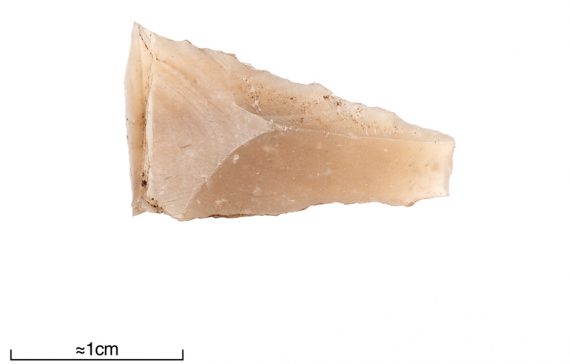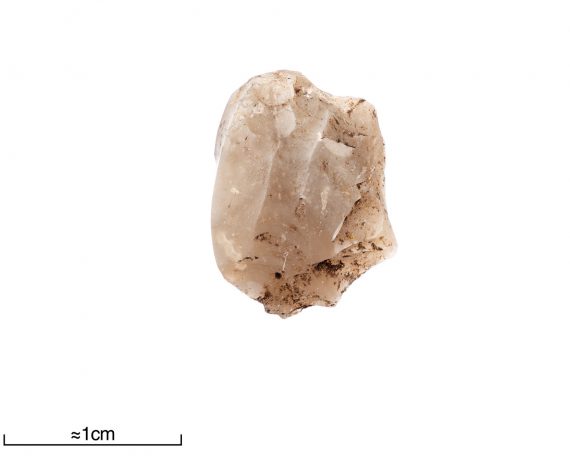Flint from the Middle trench
An overview of the finds can be found in fig. 1. The finds consist of both formal tools and lithic remains from the knapping process. The most common find types in the Middle trench are microflakes (75,3%), debitage (14,9%) and flakes (7%). Other find types, such as cores, blades, small microflakes, scrapers, points, axe fragments and knives are found in small numbers and collectively amount to 2,8%.
| Type of artefact | No polished surface/retouch | With polished surface | With retouch | With polished surface and retouch | Total | Percent |
| Flake | 149 | 52 | 6 | 0 | 207 | 7,0% |
| Debitage | 365 | 57 | 16 | 3 | 441 | 14,9% |
| Core | 10 | 4 | 0 | 0 | 14 | 0,5% |
| Blade | 22 | 7 | 3 | 0 | 32 | 1,1% |
| Microblade | 1 | 0 | 0 | 0 | 1 | 0,0% |
| Microflake | 2094 | 127 | 5 | 1 | 2227 | 75,3% |
| Small micro-flake | 5 | 0 | 0 | 0 | 5 | 0,2% |
| Scraper | 15 | 5 | 0 | 0 | 20 | 0,7% |
| Point | 5 | 0 | 0 | 0 | 5 | 0,2% |
| Axe fragment | 0 | 6 | 0 | 0 | 6 | 0,2% |
| Knife | 1 | 0 | 0 | 0 | 1 | 0,0% |
| Total | 2667 | 258 | 30 | 4 | 2959 | 100% |
| Percent | 90,1% | 8,7% | 1,0% | 0,1% | 100% |
Fig. 1. Numbers and types of finds from the Middle trench
Cores and blades are two types of lithic remains that are good indicators of which knapping techniques that were used at a site. The types of cores found in the trench are dominantly bipolar cores, 12/14 cores. Though flakes and blades produced using a platform technique show that several knapping techniques were used at Alvastra.
Polished surface appears of 8,7% of the finds, mainly on microflakes. Retouch is found on 1% of the finds (here excluding artefacts with obvious retouch, such as scrapers). The retouch is most often found on debitage. Polished surface and retouch appear on 0,1% of the finds, most often on the debitage. A large portion of the flint from the Middle trench is burnt, in total 27%, when microflakes are included. Excluding the microflakes gives a value of 35%. Cortex was found on a total of 20 finds (0,7%), 18 of them are microflakes.

Fig. 2. Object number 1285473.Transverse point, flint. Photo: Ola Myrin, Swedish History Museum (SHM).
Discussion:
A large portion of the flint from the Middle trench consists of microflakes, debitage and flakes. These are remains from the knapping process and their presence shows that knapping of flint artefacts was done at Alvastra.
Flint is not found locally in the area around Alvastra. The Senonian and Danien flints found in the discussed trench are imported from southern and south-western Scandinavia. High-quality flints were usually exported as axe preforms from areas with large amounts of flint to areas further north in Scandinavia (Burenhult 1999). The low amounts of cortex found on the flints from the discussed trench indicates that the early stages of the production chain (chaîne opératoire) were performed somewhere else. These early stages of production involve initial testing of raw material and primary stages of core preparation, which are activities that would result in debitage with cortex. Relating to this is also the relatively high amount of polished surface on the flints. Polished axes, and fragments of such, are common during the Middle Neolithic in the area and have been found to a high degree at the pile dwelling. The high amounts of polished surface on the flints could therefore be an indication that the flint was imported to the pile dwelling as polished axes and further reworked into other tools and blanks on site. It has been suggested that blade production from axes could provide a similar result as blade production from cylindrical blade cores (Knutsson 1995 and listed sources). The use of axes as a base for blade production could also explain the absence of cylindrical blade cores in these trenches, which are otherwise a common feature in Middle Neolithic materials and materials connected to the Pitted ware tradition.

Fig. 3. Object number 1284938. Bipolar core, flint. Photo: Ola Myrin, Swedish History Museum (SHM).
The presence of small, extensively used, bipolar cores from these trenches suggests that the flint was used to its maximum, something which is usually seen on sites where flint is not found locally. Bipolar technique is also a beneficial technique to switch to when a flint core (of another kind) is becoming too small for the flint knapper to hold in the hand. The technique, however, tends to result in a larger number of unusable flakes/debitage and therefore it is often used as the last step before discarding the core (Eriksen 2000).
The burning of flint artefacts, including axes, has been described as a common activity during the Neolithic (Larsson 2000a; 2000b; 2011). Flint axes and fragments from sites such as Kverrestad and Svartskylle show signs of being deliberately burnt in their final stages of the operational chain, or chaîne opératoire (Ibid.). Large amounts of flints at Alvastra (35% of artefacts, excl. microflakes) are burnt, which could be a result of deliberate burning as in the above-mentioned cases. Further studies would have to be done to investigate this.
Text: Sandra Söderlind
The following references cited on this page have no web links:
Burenhult, G., 1999. Arkeologi I Norden 1. Natur och kultur. Stockholm.
Eriksen, B.V. (ed)., 2000. En håndbog I systematiske analyser af flintinventarer. Aarhus Universitetsforlag.
Knutsson, H., 1995. Slutvandrat? Aspekter på övergången från rörlig till bofast tillvaro. Societas Archaeologica Upsaliensis. Uppsala universitet.
Larsson, L., 2000a. The passage of axes: fire transformation of flint objects in the Neolithic of southern Sweden. Antiquity. Vol. 74 (2000): 602-610.
Larsson, L., 2000b. Axes and Fire – Contacts with the Gods. In: Olausson, D. & Vandkilde, H. (eds.) Form, Function & Context. Material culture in Scandinavian archaeology. Almqvist & Wiksell International:93-103.
Larsson, L., 2011. Water and fire as transformation elements in ritual deposits of the Scandinavian Neolithic. Documenta Praehistorica, XXXVIII, s. 69-82.